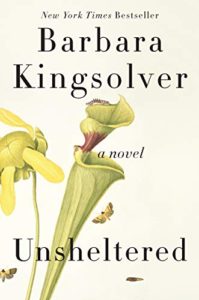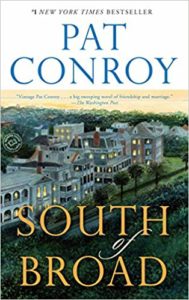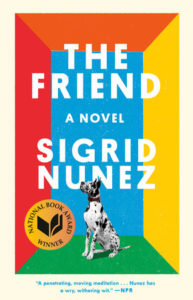Peace Like A River
Leif Enger
Grove Atlantic Publishing; 2001
Introduction
This is author Leif Enger’s debut novel in 2001. It was listed as Time Magazine’s Top Five Books of the Year. It was the Christian Science Monitor, the Denver Post, and the Los Angeles Times Best Book of the Year. This novel is an amazing journey through family relationships, tragedy, adventure, and ultimate hope in the face of all the circumstances life can throw at us.
Author
Leif Enger was born and raised and still lives in Minnesota. Before writing this, his first novel, he was a writer with Minnesota Public Radio. He has wanted to write fiction since his teens. This first novel received wide acclaim as did his second, So Brave, Young, and Handsome. He has written a total of four novels to date.
Story
The opening scene in the novel is the dramatic birth of the narrator of the story, Reuben Land. When he is born his lungs refused to work. The doctor gave him up for dead, but Reuben’s father, Jeremiah Land, prays earnestly and aggressively to God to put breath in his son. Miraculously, it happens. After this opening event, we move into the story through the eyes of 11-year old Reuben. He has a 9-year old sister Swede who he is very close to, and an older 16-year old brother Davy. His mother passed away several years earlier. The family lives in Roofing, Minnesota. The father, Jeremiah, is a school janitor at the only school in town.
As Reuben tells us the story, we learn that his father is a man of great faith who prays often and sometimes vigorously—like he’s carrying on an animated conversation with God. We learn that Reuben idolizes his older brother Davy. His younger sister Swede expresses herself by writing poetry and often through poetic storytelling that she creates in her mind and puts to paper. Reuben is in awe of her ability to express herself as he often finds himself tongue-tied. Reuben suffers greatly from asthma and some of his episodes of asthma figure prominently in the story that evolves. As the story progresses, we are told of or experience several instances in which miracles appear to happen as a result of Jeremiah’s prayerful interventions. An incident happens at the school where Jeremiah is janitor. Several boys in Davey’s class see Davey’s girlfriend Dolly go into the girls locker room during a football game and they enter the locker room and accost her. Jeremiah, working nearby, hears the commotion and goes into the locker room to investigate and encounters the boys harassing Dolly. He breaks up the encounter and finishes his work of closing up the school. The boys who were caught in the locker room didn’t take kindly to Jeremiah’s intervention. Several days later they tar the front door of the Land’s home and then a few days later kidnap Swede for several hours. Davey does not react well to any of these harassing episodes. The boys have promised they are going to get back at the family. In one amazing scene, the boys show up at the house late at night and get upstairs to the bedrooms. They enter the bedroom where Davey and Reuben are in bed and they had a bat they were going to use. Unfortunately for them, Davey was ready and had a handgun in bed with him. As the boys entered the room, Davey tells them to switch on the light. As they do, Davey fires and hits the first boy, then gets out of bed and shoots the second boy. The story then follows Davey’s arrest and trial for the killing of the two boys. After being convicted and sentenced to prison, Reuben and Swede try to dream up some way to break Davey out of prison, when all of a sudden they find out that Davey has broken out of prison. The remainder of the story tells of the family’s search for their son and brother, a search that takes them into neighboring North Dakota in the wintertime. The episodes describing their experience are a fascinating journey through the minds of an 11- and 9-year old trying to make sense of their lives. It is also a remarkable journey through the experience of Jeremiah Land, a man of intense faith who believes that God is in control of our lives and circumstances. It is a remarkable story told through amazing word pictures, through fascinating poetic storytelling, through miracles resulting from prayerful supplication to God. The end of the story is incredibly intense, and yet is a great postscript emphasizing the power of hope and faith.
Evaluation
I found this novel an amazing journey in old-fashioned story telling. I loved the way Leif Enger is able to paint word pictures. His use of words reminds me of the powerful way Pat Conroy wrote his novels on one hand, and yet also reminded me of the power of skillful story telling demonstrated by Garrison Keillor in A Prairie Home Companion radio broadcasts from Minnesota Public Radio. As a person of faith, I also appreciated the lessons in the story of the power of giving everything to God, no matter how joyous or how difficult the circumstances. If you enjoy a good story, this book will scratch that itch.
Chris’s Pick
November, 2019
Sapiens: A Brief History of Humankind
Yuval Noah Harari
HarperCollins Publishing, 2015
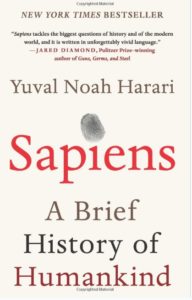
We think of ourselves, we humans, as the masters of the universe. In reality, up until 70,000 years ago, we shared the earth with at least six different evolutions of human (genus Homo). Homo Sapiens existed concurrently with Homo Neanderthalensis, Homo Erectus, and other humans for 100,000 years—some in Africa, some in Australia, some in Aisa. And, we were “insignificant animals” with ecological impact less than fireflies or jellyfish. Not until the Cognitive Revolution did Homo Sapiens –Sapiens meaning “wise” --come to dominate the earth.
This is how Harari’s Sapiens begins, with a mind-boggling introduction of pre-historic human.
He follows that with a breath-taking ride throughout our entire human history, from prehistoric until the present, and even steps beyond the “now”.
The simplest overview of this remarkable book is that Harari breaks history down into three distinct revolutions: Cognitive (70,000 years ago), Agricultural (10,000 years ago), and Scientific (500 years ago). These revolutions empowered humans to do something no other form of life has done: to create and connect around ideas that do not physically exist (think religion, capitalism, and politics).
Harari focuses on key processes that shaped humankind, such as the advent of agriculture, the creation of money, the spread of religion, and the rise of political empires. With a light touch (the book is extraordinarily readable), he explores our evolution through history, biology, philosophy, and economics, salted with illustrations and interesting examples throughout.
I have my favorite chapters. Perhaps you, like me, will be fascinated as to how the “discovery of ignorance” led to the scientific revolution. Parts of the chapter entitled The Capitalist Creed is just mind-blowing. It often feels like one is reading about two dozen separate little books. Just when you have digested, say, why the French Revolution really began, you are thrown into the Opium Wars, which culminated in Britain controlling Hong Kong as part of a drug-deal, allowing the British to continue supplying opium to an already addicted Chinese population (!)
Certainly, there has been criticism of parts of this book. Religious scholars seem to have a particularly difficult time with some of Harari’s postulations. Bill Gates (who loved the book), and others, have a difficult time with Harari’s conclusion that the Agricultural Revolution was “humankind’s greatest fraud”.
For me, though, any book that reawakens and excites the student in me is well worth reading. Almost every part of this astounding book gave me pause, caused me to sit back and think, or better yet, leave the book to research what had just been stated. Much of the last third of the book is based on contrasting opinions and perspectives—often Harari explores the same subject using three or four viewpoints, something I admire.
I am not sure I agree with everything theorized in Sapiens, but the book left me with an expansive historical structure, which I can build on as I continue to read similar books. The last chapter is truly thought-provoking, as Harari explores the fate of Sapiens in the future.
Ann’s Pick
October, 2019
All That Remains, a Scarpetta Novel, #3
Patricia Cornwell
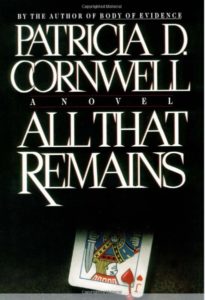 Scribner, 1992, 373 pages
Scribner, 1992, 373 pages
Mystery/Police Procedural
Strong Female Characters
Having just finished All That Remains, I’m ready for another Patricia Cornwell novel. This novel was fast paced and suspenseful as it is narrated in first-person by Dr. Kay Scarpetta, Chief Medical Examiner in Richmond, VA. Cornwell writes an intricately plotted, detail filled thriller which also has an atmospheric sense of place. We follow Dr. Kay Scarpetta and Police Detective Pete Marino as they strive to find a serial killer before he strikes again to murder another young couple along I-64 near Williamsburg, VA. The latest victim is the daughter of Drug Czar Pat Harvey. But this particular killing did not follow the usual pattern – was the victim chosen to intimidate Harvey? Was the killer a rogue FBI agent? Is there a federal cover up?
All That Remains is a hard-to-put-down page turner. It isn’t as famous as Postmortem, Body Farm or From Potter’s Field, but it does advance the characters as we learn more about Dr. Scarpetta’s friends and family, and the marital problems of Det. Marino. Scarpetta has a close brush with the killer. The ending is swift and deftly explained. However, the novel hasn’t withstood the passage of time well. Reading it, I expected Scarpetta to reach for her cell phone instead of search for the nearest pay phone. At her office she sends and receives faxes, drives in the snow to D.C. to meet with experts. There are no emails sent with attachments of photos that would have made life so much easier. And DNA is a new tool in the field of forensic science in the early ‘90’s. Edgar Award winning author Cornwell is still respected for the huge impact her Scarpetta novels have had advancing forensics in crime novels and influencing popular television series such as CSI: Crime Scene Investigation and Criminal Minds.
Still, I plan to pick up Cruel & Unusual, the next Scarpetta novel, from the library. And while I’m there I’ll look for Quantum, Cornwell’s newest mystery series featuring another strong female lead character, Captain Calli Chase, a physicist, cybercrime investigator, and NASA pilot. Will she discover the sabotage to her secret mission in time? And who is responsible? Patricia Cornwell gives us another richly detailed, thrilling new series to take on challenges and crises of the 21 st century. Happy Reading!
plan to pick up Cruel & Unusual, the next Scarpetta novel, from the library. And while I’m there I’ll look for Quantum, Cornwell’s newest mystery series featuring another strong female lead character, Captain Calli Chase, a physicist, cybercrime investigator, and NASA pilot. Will she discover the sabotage to her secret mission in time? And who is responsible? Patricia Cornwell gives us another richly detailed, thrilling new series to take on challenges and crises of the 21 st century. Happy Reading!
And Coming October 2019, the 1st of Patricia Cornwell’s newest series: QUANTUM, By Patricia Cornwell; A Captain Chase Novel, #1;Thomas & Mercer 2019
Unsheltered
Barbara Kingsolver
Here’s a little plug for a possibly unknown collection of books: the Lucky Day books. I happened to look around the circulation desk as I was checking out and noticed Unsheltered. Since I’m a big fan of Kingsolver, I added it to my selections.
The novel is set in the 2016 election cycle. Kingsolver introduces us to relatable characters: a long-married couple, Willa and Iano; his father, Nick, a vocal conservative who is living with them because of poor health; and their children, Zeke and Tig, who have landed back in the parental nest for very different reasons.
In a stroke of bad luck, Willa has not only lost her job as a magazine writer, but the house she has inherited from her aunt is literally falling down around her. Her husband, a professor, gained tenure from only one university, and it closed. So here Willa and Iano find themselves with no retirement and minimal services available because they make a bit too much money—as well as being part of the sandwich generation, with demands from both young and old.
In a parallel story, we see there is a second set of characters from the 1800s, who lived in the house just after the foundation-less additions of the title were made: Thatcher Greenwood, a teacher; his wife and her mother and sister; and his unconventional neighbor, Mary Treat, a scientist who corresponds with Charles Darwin.
Kingsolver has yet again given us a compulsively readable, relatable story. I hope you enjoy it as much as I did.
Sonja’s Pick
August, 2019
The Storyteller’s Secret
Sejai Bodani
Published September 1, 2018
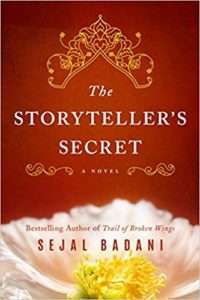 Jaya experiences a 3rd miscarriage and her marriage succumbs. In desperation she travels to her mother's India to learn secrets of her family's past. She is welcomed by Ravi, a servant of her grandparents and he relates the story of a young girl, her grandmother Amisha.
Jaya experiences a 3rd miscarriage and her marriage succumbs. In desperation she travels to her mother's India to learn secrets of her family's past. She is welcomed by Ravi, a servant of her grandparents and he relates the story of a young girl, her grandmother Amisha.
We begin when Amisha moves in with her new husband and family, a tradition at that time and is treated quite poorly. She is different from others, more loving and we like her from the start finding compassion in what she must contend with.
We are taken from the 1930's of her grandmother to Jaya in the present. Jaya finds solace and courage to mend upon hearing of her grandmother's strength and love.
The traditions of the time are quite severe and new to most of us Americans. And that's what I enjoy learning about—another culture. Please enjoy this book as much as I did.
Ann’s Pick
July, 2019
ALWAYS LOOK ON THE BRIGHT SIDE OF LIFE
Eric Idle
 New York: Crown Archetype, [2018]
New York: Crown Archetype, [2018]
289 pages, 8 unnumbered pages of plates : illustrations (some color)
Unabridged Audiobook, Eric Idle author and narrator
8 audio discs (8 hr., 13 min.); Westminster, MD: Books on Tape, 2018
This funny and upbeat memoir written and told by founding member of Monty Python Eric Idle is sure to entertain! The book and audiobook are packed with humor and the writing is richly detailed with behind-the-scenes tales of Hollywood and London. Eric’s well-crafted dialog will have you smiling, singing and laughing out loud.
Eric Idle tells the story of his life with wit and heartfelt honesty. Did you know that “Always Look on the Bright Side of Life” is the most requested song at British funerals? Yes, it is. And the audio book is such a delight because you hear Eric singing it for you. Listened to the book in the car and it always had me laughing on the way home.
The book has lots of photos, too – Eric with George Harrison, his best friend and without whom Life of Brian would not have been made; Eric with David Bowie, Robin Williams, Mick Jagger, Carrie Fisher, Steve Martin and of course the other Pythons, also life long friends. Eric describes his childhood in post-WWII England, his education, how he met John Cleese and the other Pythons. Of course, there are stories about Monty Python’s Flying Circus, Life of Brian and the creation of the Broadway smash, Spamalot, and reflections on the meaning of life.
If you love Eric Idle, Monty Python, Spamalot and/or British humor, this is the book for you – wink wink, nudge nudge, say no more!
Karen's Pick
June, 2019
The Cook
Maylis de Kerangal (translated from French by am Taylor)
Farrar, Straus and Giroux, New York
March 26, 2019
French author Maylis de Kerangal’s (The Heart -2013) The Cook is a beautiful 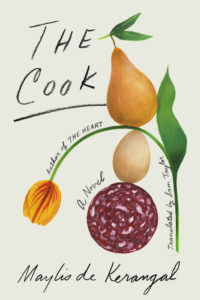 atmospheric novel that at times is so hyper-realistic it seems to be a biography. The simply stated book title refers to the main character Mauro, a young Frenchmen, who is passionate about food and cooking. I think it fair to state that to fully appreciate this story the reader should define themselves as a “foodie”; but not only the sort of ‘foodie” that enjoys a great meal, but the kind that goes to bed and wakes up thinking about food, believes a visit to the food market is an outing or an opportunity to unearth a culinary treasure, and one who chooses not to serve a complicated preparation that may be only somewhat underwhelming!
atmospheric novel that at times is so hyper-realistic it seems to be a biography. The simply stated book title refers to the main character Mauro, a young Frenchmen, who is passionate about food and cooking. I think it fair to state that to fully appreciate this story the reader should define themselves as a “foodie”; but not only the sort of ‘foodie” that enjoys a great meal, but the kind that goes to bed and wakes up thinking about food, believes a visit to the food market is an outing or an opportunity to unearth a culinary treasure, and one who chooses not to serve a complicated preparation that may be only somewhat underwhelming!
The author invokes the help of an unnamed narrator to introduce Mauro’s episodic story that begins with Mauro as a young teenager. Mauro views the family kitchen as part play ground and part laboratory and continually treats his five friends, who are collectively known as the Aulnay Six, to picnic meals that are carefully thought out, well executed, and appropriately underappreciated by the teenagers. Throughout his formative years his interest in food persists and develops into a way of life that is in no way altered by earning a Master’s Degree in Economics. He unreservedly puts the university degree aside and we “witness” his transformation from student to a cook to a culinary master. It is increasing clear that Mauro never loses sight of what has driven his life- the quest for exceptional food products, development of a remarkable work ethic, the ability to provide incomparable dining experiences, and his continual search for the next inspiration.
As a developing chef he travels from France to Thailand, to Burma and again back to France working in kitchens looking for “tastes that give him back the capacity for surprise”. Mauro’s experiences serve as a platform for the answer to the question that plagues him–what am I doing? Singularly he searches for the answer as he travels from country to country, restaurant to restaurant, kitchen to kitchen.
However, if he were interested in external sources, Mauro would find the answer from restaurant reviewers and food enthusiasts. The narrator informs us that Mauro’s followers are food devotees who understand that “Contrary to what many believe, the most gifted and innovative chef is not necessarily the one who transforms the ingredients, but the one who most intensely restores their flavor”.
For this reader, Mauro’s experience is reminiscent of Anthony Bourdain’s confessional of a chef’s life in Kitchen Confidential, and an emergence of self, in James Joyce’s A Portrait of The Artist as a Young Man. As in both these books Mayla de Kerangal’s The Cook, skillfully creates story that allows for an armchair tour of a man’s life journey that is purposeful, and determined.
I highly recommended this book to readers who are food enthusiasts, lovers of a prosaic story, and are thoughtful participants in ones life experiences.
Chris’s Pick
May, 2019
Educated, A Memoir
Tara Westover
Random House Publishing, 2018
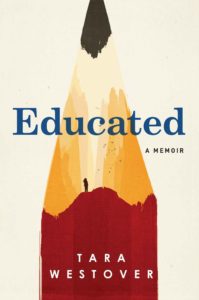 Tara Westover was born in the shadow of a remote mountain in Idaho, sometime in September of 1989 (no birth certificate issued), the youngest of seven children. Because her Mormon survivalist parents believed the government was coming to raid and kill them at any moment, and that the End of Days was upon them, much time was spent in preparation for these events. Her paranoid, most-likely bi-polar, father refused to allow the children any schooling beyond what they could glean themselves from the Bible or Mormon texts. Despite horrific accidents, medical attention was also disallowed. Herbs and tinctures and the will of God was all that was needed.
Tara Westover was born in the shadow of a remote mountain in Idaho, sometime in September of 1989 (no birth certificate issued), the youngest of seven children. Because her Mormon survivalist parents believed the government was coming to raid and kill them at any moment, and that the End of Days was upon them, much time was spent in preparation for these events. Her paranoid, most-likely bi-polar, father refused to allow the children any schooling beyond what they could glean themselves from the Bible or Mormon texts. Despite horrific accidents, medical attention was also disallowed. Herbs and tinctures and the will of God was all that was needed.
As a teenager, Tara discovers a love for music, which drives her determination to attend college. She self-teaches algebra and trigonometry in order to attain an ACT score that admits her into Brigham Young University. From there, she discovers literature, and then history, learning for the first time about such things as the Holocaust, and the civil rights movement.
That is the beginning of the story, and the simple end is that Westover’s fascination with history takes her to Cambridge and Harvard and finally a PhD. But as astonishing as that is, Westover’s journey in self-discovery was as internally harrowing as her childhood. There is justified anger and outrage at her upbringing, yet continued curiosity and love for her family –even for those who have terribly wronged her--plus an overwhelming guilt for abandoning ingrained beliefs. These conflicting emotions are so completely present it is a source of real anguish for Westover. Finally, cutting ties with her father is the only solution.
Everything I had worked for, all my years of study, had been to purchase for myself this one privilege: to see and experience more truths than those given to me by my father, and to use those truths to construct my own mind. I had come to believe that the ability to evaluate many ideas, many histories, many points of view, was at the heart of what it means to self-create.
And at the heart of what it means to be educated.
Beyond this fascinating story is how beautifully written this book is, and that is remarkable in and of itself. In an interview with Westover, she explains that in college she learned what a short story was; having never read one before. She was so enchanted by the structure of this art, she crafted each chapter of her book as if it were a short story in its own right. The technique works; she has created a very readable, highly recommended, memoir.
Barbara’s Pick
April, 2019
Good Riddance
Elinor Lipman
Published by Houghton Mifflin Harcourt, February 2019
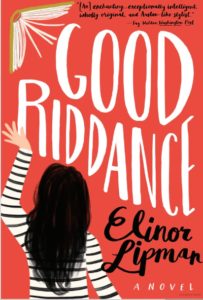 When I heard the premise of Good Riddance, I was immediately hooked: A high school teacher to whom the yearbook had been dedicated dies and leaves her heavily annotated yearbook to her older daughter. The daughter, referencing Japanese organizational wiz Marie Kondo, decides the yearbook does not “spark joy” and leaves it in her NYC apartment building’s recycling bin, where it’s picked up by another resident, who decides to go to the class’s 50th to do research for a documentary (which becomes a podcast instead).
When I heard the premise of Good Riddance, I was immediately hooked: A high school teacher to whom the yearbook had been dedicated dies and leaves her heavily annotated yearbook to her older daughter. The daughter, referencing Japanese organizational wiz Marie Kondo, decides the yearbook does not “spark joy” and leaves it in her NYC apartment building’s recycling bin, where it’s picked up by another resident, who decides to go to the class’s 50th to do research for a documentary (which becomes a podcast instead).
The heroine, a former Montessori teacher whose current “job” is completing an online chocolate-making course, has her own baggage, not the least of which is how to get her mother’s yearbook back from the neighboring busybody who snatched it. The author has quite a cast of characters and manages to weave them all through the plot in the most charming way.
This book was utterly delightful. Apparently the author has written 11 novels before this one, and I’m excited to read the others!
Pete’s Pick
March, 2019
South of Broad
Pat Conroy
Published by Doubleday, 2009
This is one of several great novels written by Pat Conroy, who writes with great passion about the South. This novel takes us on an intense inside look at one of the great Southern cities, Charleston, SC. The focus of the novel is following ten young people entering their senior year of high school and growing into adulthood during the mid-1970’s and 1980’s. The setting is the area of Charleston known as South of Broad—the area with all the aristocratic mansions for which Charleston is famous.
Author
Pat Conroy grew up as one of seven children of a U.S. Marine Corps officer and lived on a number of military bases throughout the South. After attending the Citadel in Charleston, he taught high school English and Pyschology in Beaufort, SC. In 1969, he took a job teaching underprivileged kids in a one-room school house on Daufuskie Island near Hilton Head Island in South Carolina. He was let go from this teaching position after one year because of what the school system characterized as unconventional teaching methods and his refusal to allow corporal punishment of his students. He wrote about his experiences that year in a memoir called The Water is Wide, which became a major motion picture. He then continued writing as a career and has written a number of novels which made it to the big screen. He passed away in 2016 as the result of pancreatic cancer. He is reknown for his lyrical style of writing and for storytelling in a way that is very captivating. In my opinion, he has a unique way of looking inside the human experience and is able to put it to words in a way that allows us to really experience what the characters are experiencing.
Story
The setting for this novel is Charleston, South Carolina from 1969 through 1990. In specific, the focus is on the area of Charleston known as South of Broad, which is where all the aristocratic mansions are located—the ones for which Charleston is famous. The story follows 10 students who are entering their senior year of high school. The narrator of the story, Leopold Bloom King, is the son of the Peninsula High School principal, Dr. Lindsay King, and one of the science teachers at the high school, Jasper King. The story follows Leo and nine other high school seniors he meets the first day of school as they go through that last year of high school. Four of the seniors are black and are experiencing their first time attending a predominately white high school. By the same token, this is the first year Peninsula High has had black students as part of the student body. Two of these new students are orphans who have just arrived at and are living at a nearby orphanage.
The story follows these 10 students through the eyes of Leo as they experience the tensions of racial integration, raging hormones as teenagers, and the tension that exists between those from the aristocratic society and those from the working class part of society. We follow the guys as they are members of the school football team which for the first time has a black coach and the gals as they make up part of the cheerleading squad. We also get introduced to the world of homosexuality as Trevor begins to act out his attraction for same-sex relationships.
The story skips over college years and takes us into the late 70’s and early 80’s as the friends have entered their careers in law, writing, acting, music, and home making. We experience the tensions of social status and loose morals and the beginnings of the AIDS epidemic. We get to witness how the experiences of that senior high school year have provided a foundation for the friendships and relationships that exist 20 years later. This foundation becomes extremely important as Trevor is known to have developed AIDS but goes missing in San Francisco, and the friends respond to his twin sister Sheba’s plea to help her find Trevor. As the story makes its way to its conclusion, we get to experience Hurricane Hugo in 1989 as it clobbers Charleston and these friends are thrown together to survive the storm and its aftermath. The bittersweet conclusion takes us through the deep despair and horror of tragic loss of life and its aftermath, but ultimately leaves us with the hope that through the human experience we can find hope, support, and love to see us through our years.
Evaluation
I love reading Pat Conroy’s novels because of the unique way he has painting word pictures while telling a compelling story. The way he creates his sentences and paragraphs absolutely draws me in to the story and it literally plays out in my mind as I read. I’m right there with the characters experiencing what they are experiencing. It was also wonderful following the story in Charleston, which is a city where my wife and I spend Thanksgiving every year on our way home from our annual vacation in Hilton Head. If you love words, you’ll love Pat Conroy. If you’ve ever diagrammed sentences in English class, his novels will give you an amazing challenge. The reading is vigorous. It’s like a movie going on in your head. It’s intense. And it’s heart wrenching. I loved it.
Karen's Pick
February 2019
Reader Beware! If you choose to read this book, don’t be misled by
- the happy and colorful book jacket
- the sweet looking dog on the cover of the book
- the books mere 211 pages being a guise for a quick read
Sigrid Nunez’s The Friend is the recipient of the 2018 National Book Award for Fiction. In the first few pages the author does a remarkable job of drawing the reader into the story by her use of artfully crafted prose. It is soon realized that the journey the writer will take us on is going to be unfamiliar. The human characters in the book are all unnamed; the book is presented with typical chapters but the pages present as a diary, or a notebook; there are multiple “plots” or storylines, and the narrative point of view repeatedly shifts. This reader has read and enjoyed previous National Book Award winners, Whitehead’s Underground Railroad in 2016 and Ward’s Sing Unburied Sing in 2017, and realizes the shared standards; books that have won this award are creatively written, highly inventive, morally inspired, and culturally relevant.
The Friend is a literary novel, (often) written in first-person present. The story is about loss and losing, grief and grieving, and love and loving. The author’s use of these charged emotions disarms and often forces the reader to relive personal experiences.
Nunez gives us limited information about her unnamed characters in The Friend. The “Narrator” in the book is a middle aged, female, college English professor, who is the best friend of “You”. You is a late middle aged, male, womanizer, writer, literary mentor, and one-time lover of the narrator, who commits suicide. The only character Nunez names is Apollo, a 180-pound male Harlequin Great Dane, a rescued dog who is traumatized after You’s tragic death.
The reader becomes acquainted with The Friend’s characters through Nunez’s talented writing and skillfully description of the impact of suicide has on them. The Friend’s Narrator is confounded by the suicide of You and struggles to reconcile his being gone. Her use of denial, subversion, and anger prove to be unsuccessful and we see her unraveling. Apollo, You’s awkward-looking Great Dane, is anthropomorphically presented as an abandoned and bereft being and in need of a home. Nunez trusts in the ability of the reader to relate to Apollo’s loss and offers the reader relief when the Narrator agrees to bring the dog home to her 500sq foot NYC apartment. It is at this point that the book becomes the essence of The Friend. The relationship between the narrator and Apollo transforms from that of an owner of a displaced animal to a magical partnership since she believes that they equally suffer from the loss of You. Nunez substantiates this belief through many literary references in the book. From the poet Rilke the Narrator gains understanding of her relationship with Apollo,
Perhaps all the dragons in our lives are princesses who are only waiting for us to act, just once, with beauty and courage. Perhaps everything that frightens us is, in its deepest essence, something helpless that wants our love.
In The Friend, death by suicide not only relates to the loss of “You”. Nunez uses the subject of suicide to symbolize the continuing erosion and slow death of the literary profession. The Narrators reference to the lack of honesty, relevant questioning and integrity of her literary colleagues and writing students leads the reader to believe that these statements are based on the authors’ own experiences. Using more of literary quotations in The Friend, Nunez supports the Narrators thoughts about her profession,
All writers are monsters. Henry de Montherkant
Writers are always selling someone out. [Writing] is an aggressive, even a hostile act….the tactic of a secret bully. Joan Didion
Any writer worth his salt knows that only a small proportion of literature does more than partly compensate people for the damage they have suffered in learning to read. - Rebecca West
There were times that reading The Friend book was a bit of a challenge. It was common for this reader to “ask Google” for information to fully understand the authors intent, especially when the Narrator asks, “Why dogs could not have a Proustian moment". In discussing my reaction to the authors need to include this question in the book with my friend; ironically she responded by sending me a quote from a Proust essay “…Complexity should never be a barrier to intellectual curiosity”. It would be wise for the would- be reader to remember this quote when deciding to read The Friend and approach the book with the level of inquisitiveness Nunez requires.
Barbara’s Pick
January 2019
The Dinner List
Rebecca Serle
Publication Date: September 11, 2018
Most if not all of us have played this game—invite a number of people, living or dead, to a dinner party and see what unfolds. This book is about the dinner of the protagonist, Sabrina Nielsen, with five people: her estranged father, Robert, who is dead; her favorite college professor, Conrad; her on again/off again boyfriend, Tobias; her best girlfriend, Jessica; and Audrey Hepburn (obviously dead). One more of the guests is dead, but we don’t learn that until later.
Sabrina is turning 30 and not settled in her life. She has never forgiven her father, a recovering alcoholic, for leaving the family. She’s irritated with her ex for never committing. She’s upset with her friend for growing into an adult and leaving her behind. But she’s really happy to see Conrad and to meet Audrey, for whose movie character she is named. In the hours between 7:30 and midnight, a huge amount of life is relived and some walls are broken down.
As long as you can suspend belief, this book is sweet and sad, cathartic and campy. It’s a relatively quick read, easily accomplished in a weekend—perfect for a snow day this winter. Reservations, anyone?

